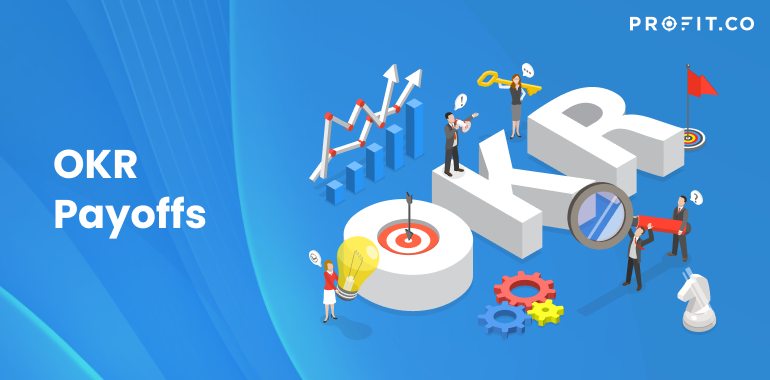Good OKR programs in any company can win a competitive advantage for the company in its own way, one of the main reasons being intense focus on corporate goals and team’s goals rather than that of individuals. You have to ensure that your OKRs are aligned with the strategy of the organization and then choose the objectives and ensure that the key results you’ve come up with are really the right ones. Whatever is your organizational DNA, OKRs address a few more vital challenges and the Payoffs are amazing. OKR Payoffs can be expressed using the acronym FACTS and is illustrated in the here.

Focus
A key guideline when practising OKRs is to limit the number of objectives to 3-4 per person and limit the number of key results to 2-5 per objective. This guideline is in place to bring exceptional focus to what you are trying to accomplish. This also forces you to prioritize and pick the key results that matter the most at that point.
Alignment
Again, by design, OKRs are public and available to everyone in the company. Because of that transparency, it makes it easier for employees to align with the appropriate objectives of others that they are either impacting or impacted by. When you are able to express alignments and are able to visualize them, every employee can understand and realize the impact they are having beyond themselves, or their teams, or departments. Organizations achieve alignment both using a top-down approach and a bottom-up approach, the extent of each alignment will be different at different levels of the organization and how to straddle between both the alignments is your organization’s unique DNA.
Commitment
While OKRs are set at every level of the organization, through dialog and discussions, every employee sets up their own OKRs. They do get assigned OKRs by managers, but for the most part everyone comes up with their OKRs. As documented in the IKEA Effect, every employee will show a lot more commitment to achieving their OKRs, since they came up with them.
Tracking
This is one of those key differences between the traditional performance reviews and OKRs. You check in pretty much every week. You can use any kind of review methodology. The Progress, Plan and Problems (PPP) methodology is widely used and supported by Profit.co Its very effective if employee checks in for all their OKRs and then complete their PPP assessment.
Stretching
Assuming the features are of equal size, which of the following is better?
- Someone commits to delivering 3 features and delivers 4 features
- Someone commits to delivering 10 features and delivers 8 features
The answer is obvious.
However, traditional management systems encourage #1, while OKR encourages #2. If you achieve 100% of your OKRs, it most likely means that you are not setting aggressive enough targets for yourself. The ideal level of achievement is 65%.
Good implementations deliver accurate measurements into the hands of decision-makers with as much objectivity as possible ingrained in the data. It should empower those entrusted with organizational success to increase the likelihood of a stated destination being reached within a commercially acceptable set of parameters.



